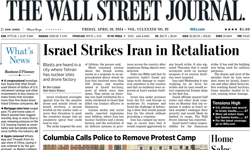Most print media brands have now got the internet worked out. They’re online, with websites, blogs, RSS feeds, and they’re up to speed. Or so they think.
But there’s a whole load of new media and technologies out there that are continuing to change the way the internet works. Tim O’Reilly coined the phrase ‘Web 2.0’ some time ago, and as JB Holston, CEO of Newsgator, says, ‘There’s a load of new stuff out there.’ Indeed, some new media commentators have said they think developments today are as exciting as in the last dot com boom.
The editor - RIP
One big trend right now is social media - from communities such as Myspace and Friends Reunited to collaborative filtering and wikis. Probably the single most radical feature - and which divides them absolutely from traditional media models - is the removal of the editor. Some do not even retain token moderators; others attempt to replace the editor either with tagging and other metadata, or with solid structures and procedures for enabling debate. Martin Stiksel, of Last.fm, a collaborative music recommendation site, says ‘We have 1.6m new music fans, not one editor. The very first decision we made at Last.fm was to do away with editors.’
JB Holston, of Newsgator, says that this reflects a feeling among social media proponents that collective intelligence is better than a single opinion. ‘The general proposition for wikis is that the long tail can collectively be more intelligent than the short tail.’ So Wikipedia, for instance, instead of calling on the services of one knowledgeable person for an article, is able to make use of a large number of different people’s specialised knowledge. But, he says, this makes social media quite different from the traditional media - ‘It’s a tool, a platform for interaction, not an editorial voice.’
Some social media looks rather pointless. Martin Stiksel says of these, ‘You get a load of friends, and then what?’ But, increasingly, we’re seeing it evolve beyond purely social networking, and supporting special interest communities, or specialised media, creating substantial value for members. Martin defines Last.fm, and other media like it, as ‘social networking with a point’ - and it’s here that it probably impacts most on traditional media.
Interestingly, some of the largest users of social media techniques are online retailers, not traditional media companies. For instance Stephen Brooks, publisher at mad.co.uk, is a great admirer of collaborative filtering. And he quotes Amazon.com as one of its best implementations - recommending books to users based on their previous selections.
The blogosphere
Blogging, too, creates a ‘blogosphere’ in which collective knowledge is greater than any single blog. Adriana Cronin-Lukas points out that ‘It’s all one big peer review’, with blogs linking to and talking about other blogs. In this case, the pure social network has crossed over into being a collaborative information provider - it may not look at all like the traditional media but it is out for the same share of readers’ time.
Social media, and the rise of blogging, has also led to a disintermediation of content. For instance, JB Holston says, ‘There are bloggers in the US who make more money as bloggers than the journalists they’re competing with’, by selling ads on the site. They are speaking to their audience direct - not contributing to a newspaper or magazine. And some of the best are getting a lot of credibility now (which wasn’t always the case in the early days).
Disintermediation applies to the corporate sector too. Adriana Cronin-Lukas, of the Big Blog Company, points out that companies which run their own blogs can enjoy privileged access to their consumer base, offering more specific content than is usually found in the media. IBM has been particularly good at running blogs, she says, but other companies are now getting in on the act.
Another major trend at the moment is the move to a web services world. That includes a number of technologies - from service orientated architectures within major corporates to RSS, and including the semantic web and mashups. All of these technologies enable data from numerous sources to be integrated and manipulated - a database is no longer a stand-alone object but part of a wider information world.
RSS
The most obvious impact on the media has come from RSS. While it’s easy to see RSS as another distribution medium, similar to email, in fact it goes much further. RSS can be used to integrate content into other sites - so readers can become editors, offering content from a number of different sources. That means your content might pop up on someone else’s site - changing the context and presentation. Even just as a distribution medium it may change readers’ habits - for instance you might want to select property and finance news from the Telegraph, political news from the Indie and football news from the Guardian. That breaks down the monolithic medium of the newspaper and puts the reader - not the paper - in control.
Sarah Lelic, editor of mad.co.uk, believes that RSS will become critical for B2B media. ‘Content online is moving to tailored content, particularly in the time-poor, B2B arena. People don’t have the time to surf,’ she says. She believes this will lead to a concentration of the major media. ‘I have a hunch that people will end up with 5 or 6 trusted web brands and perhaps 20 or 30 RSS feeds. People only have room for a certain amount of proper web browsing.’
Mashups
Mashups are probably the most extreme new medium. They take information from a number of databases and tie it together to create new products - for instance, a crime map of Chicago, based on Google Maps, together with police data. At the moment, most are free, and based on freely available content. But at some time creators will want to monetise them, and then we’ll have to face the issue of who owns the data and how the fees should be shared. JB Holston says ‘It’s all ‘To Be Determined’. Lawyers are loving this era. It’s a new world of mashup IP.’
One issue for the media is that, as Adriana Cronin-Lukas says, with RSS and blogs ‘You control the message - you do not control the impact. It’s a network world, not a channel world.’ Delivering a story to RSS, you don’t control the look and feel of presentation, or the context in which it is seen, or the route through which people access it.
Media coming from the print world have often tried to integrate these new trends - but they have usually failed. JB Holston says some traditional media are now hiring bloggers - but the Washington Post fired their conservative blogger after three days. (They’re now looking for another one.) And Martin Stiksel thinks a lot of the ‘new media’ on newspaper sites is just ‘emperor’s new clothes - paying lip service to new trends, but mainly working in the old way.’
Adriana Cronin-Lukas agrees. ‘Media companies aren't looking at their core competencies and competitive advantages, they’re just looking for new sources of revenue. They’re changing where they get their money - not what they do.’
Changing roles
Instead, the more traditional media need to rethink their role radically, says Stephen Brooks. The place of the editor is still relevant; with over 50 million blogs worldwide, Sarah Lelic says that ‘Relevance is still the big issue.’ That prioritises the editorial task of sorting, filtering and rating data. And Stephen Brooks is quite happy to go this route - Mad is launching a branded feedreeder, through which users can access not just Mad content, but other content that is relevant to them.
Stephen says, ‘We deliver content, but we accept that we don’t have to create all of it. We’re bringing together information that we think has a value to our audience, so we’ll become both a content creator and a mediator or aggregator.’
This does raise some interesting issues. How can a strong editorial voice be maintained, if new voices and external content are being invited into the medium? JB Holston believes that now ‘We’re seeing some print media blowing up their brands online, or they’re atomising their brands online is how I think about it.’ RSS feeds already break the brand up into portions that a reader can subscribe to separately. Now we’re seeing the creation of sub-brands such as the Guardian’s ‘Comment is free’.
Early days
JB Holston also believes that, while social media and RSS will make a huge impact, it’s too early to say exactly how. ‘It’s too early for a strategy - you need a bunch of tactics.’ He believes News International’s acquisition of Myspace is one of those tactics. ‘It wasn’t based on a holistic view of how it would contribute to the News International empire, it was tactical - it’s got a big audience, let’s grab that.’
But the boundaries between reader and editor are becoming blurred. In the blogosphere, bloggers are all both readers and editors - there is no hard distinction between the two roles. So the task in which editors are engaged is now more similar to the task in which their users are engaged. Martin Stiksel says that the ‘one to many’ broadcast model has been superseded. ‘Many to one is the new model. One to many is the old way - we believe in the bottom up.’ And Adriana Cronin-Lukas goes even further. ‘It’s many to many - you read others and use their content. You can use the internet as your own medium.’
That is the ultimate challenge for the traditional media. They don’t just have new competitors - their readers are becoming their competitors. That’s going to make life very interesting for the next few years.
FEATURE
Web services
One of the most exciting, or terrifying (depending on your outlook), aspects of the web is the breakneck speed at which new technologies roll out. The speed of change today (and tomorrow) is as fast as at any time in the online era. Andrea Kirkby tries to keep up.










